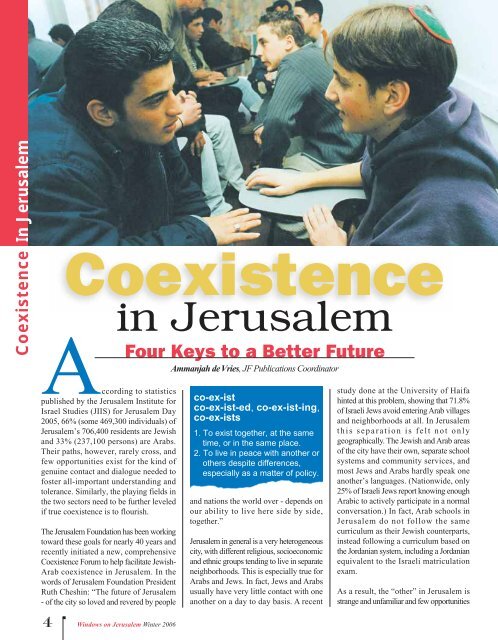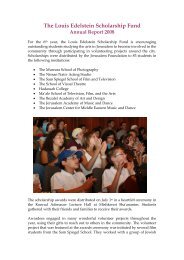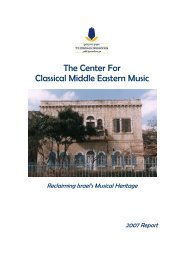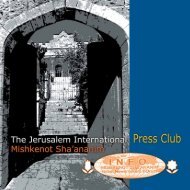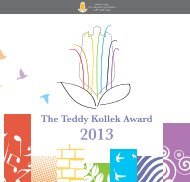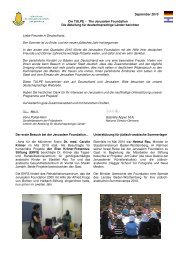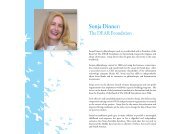Windows Winter 2006 - Jerusalem Foundation
Windows Winter 2006 - Jerusalem Foundation
Windows Winter 2006 - Jerusalem Foundation
You also want an ePaper? Increase the reach of your titles
YUMPU automatically turns print PDFs into web optimized ePapers that Google loves.
In <strong>Jerusalem</strong><br />
Coexistence<br />
Coexistence<br />
in <strong>Jerusalem</strong><br />
Four Keys to a Better Future<br />
Ammanjah de Vries, JF Publications Coordinator<br />
According to statistics<br />
published by the <strong>Jerusalem</strong> Institute for<br />
Israel Studies (JIIS) for <strong>Jerusalem</strong> Day<br />
2005, 66% (some 469,300 individuals) of<br />
<strong>Jerusalem</strong>’s 706,400 residents are Jewish<br />
and 33% (237,100 persons) are Arabs.<br />
Their paths, however, rarely cross, and<br />
few opportunities exist for the kind of<br />
genuine contact and dialogue needed to<br />
foster all-important understanding and<br />
tolerance. Similarly, the playing fields in<br />
the two sectors need to be further leveled<br />
if true coexistence is to flourish.<br />
The <strong>Jerusalem</strong> <strong>Foundation</strong> has been working<br />
toward these goals for nearly 40 years and<br />
recently initiated a new, comprehensive<br />
Coexistence Forum to help facilitate Jewish-<br />
Arab coexistence in <strong>Jerusalem</strong>. In the<br />
words of <strong>Jerusalem</strong> <strong>Foundation</strong> President<br />
Ruth Cheshin: “The future of <strong>Jerusalem</strong><br />
- of the city so loved and revered by people<br />
co-ex-ist<br />
co-ex-ist-ed, co-ex-ist-ing,<br />
co-ex-ists<br />
1. To exist together, at the same<br />
time, or in the same place.<br />
2. To live in peace with another or<br />
others despite differences,<br />
especially as a matter of policy.<br />
and nations the world over - depends on<br />
our ability to live here side by side,<br />
together.”<br />
<strong>Jerusalem</strong> in general is a very heterogeneous<br />
city, with different religious, socioeconomic<br />
and ethnic groups tending to live in separate<br />
neighborhoods. This is especially true for<br />
Arabs and Jews. In fact, Jews and Arabs<br />
usually have very little contact with one<br />
another on a day to day basis. A recent<br />
study done at the University of Haifa<br />
hinted at this problem, showing that 71.8%<br />
of Israeli Jews avoid entering Arab villages<br />
and neighborhoods at all. In <strong>Jerusalem</strong><br />
this separation is felt not only<br />
geographically. The Jewish and Arab areas<br />
of the city have their own, separate school<br />
systems and community services, and<br />
most Jews and Arabs hardly speak one<br />
another’s languages. (Nationwide, only<br />
25% of Israeli Jews report knowing enough<br />
Arabic to actively participate in a normal<br />
conversation.) In fact, Arab schools in<br />
<strong>Jerusalem</strong> do not follow the same<br />
curriculum as their Jewish counterparts,<br />
instead following a curriculum based on<br />
the Jordanian system, including a Jordanian<br />
equivalent to the Israeli matriculation<br />
exam.<br />
As a result, the “other” in <strong>Jerusalem</strong> is<br />
strange and unfamiliar and few opportunities<br />
4 <strong>Windows</strong> on <strong>Jerusalem</strong> <strong>Winter</strong> <strong>2006</strong>


